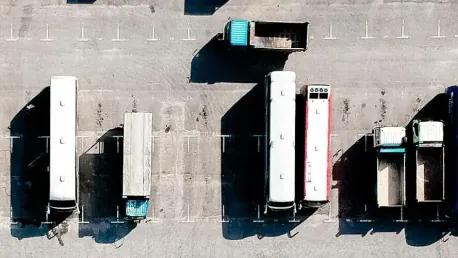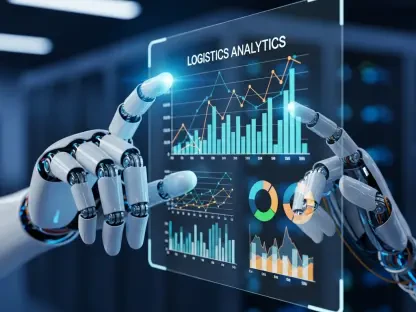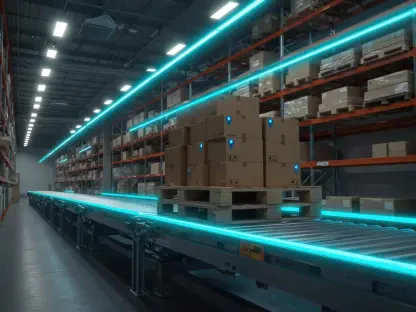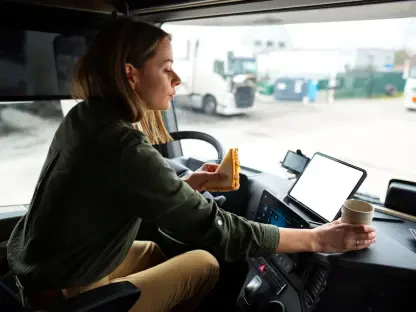To meet the evolving demands of logistics and distribution center operations, Mitsubishi Electric Automotive America (MEAA) has unveiled its innovative HubPilot™ autonomous distribution yard logistics platform. Positioned as the first in the market to leverage an advanced combination of software, on-vehicle sensing, infrastructure-based perception, and high-definition mapping, HubPilot aims to dramatically enhance operational efficiency, safety, and security.
Technological Integration for Advanced Logistics Management
Cutting-Edge Software and On-Vehicle Sensing
The cornerstone of HubPilot’s capabilities lies in its integration of cutting-edge software with on-vehicle sensors. These sensors are placed on autonomous yard dogs, also known as rovers or terminal tractors, to facilitate precise localization and navigation within geofenced environments. The synchronization of these tools allows for the accurate identification and transport of designated trailers.
High-definition mapping technology embedded in HubPilot ensures each yard dog has a comprehensive view of the yard layout. This feature is critical for efficient and autonomous operations, providing real-time data to avoid potential obstacles and optimize route planning. The seamless synergy between software and hardware enables HubPilot to perform complex tasks that would typically require significant human intervention. By combining these advanced technologies, MEAA has created a robust system that can autonomously manage the intricate logistics of busy distribution centers.
Further enhancing its operational capability, HubPilot’s software continuously processes vast amounts of data collected from on-vehicle sensors. This real-time analysis allows the system to adapt to changing conditions within the yard, ensuring smooth and efficient movement of trailers and yard dogs. The fusion of high-definition mapping with on-vehicle sensing represents a significant technological leap in autonomous logistics, paving the way for more sophisticated and reliable yard management solutions.
Infrastructure-Based Perception
Complementing the on-vehicle sensing, infrastructure-based perception adds another layer of intelligence to the yard management process. By placing sensors throughout the yard, HubPilot eliminates blind spots and ensures continuous monitoring of the entire operational area. This dual-perception approach significantly enhances the safety and security measures within the yard, creating a more controlled and predictable environment for autonomous operations.
Infrastructure-based perception works in tandem with the on-vehicle sensors to provide a holistic view of the yard’s activities. This integrated approach not only boosts operational efficiency but also minimizes human error, thereby enhancing overall yard productivity. The strategic placement of sensors within the infrastructure allows for constant surveillance, ensuring that every movement and activity is meticulously monitored.
Advanced algorithms process the data collected from these sensors, enabling HubPilot to make intelligent decisions based on real-time information. This capability allows the platform to respond swiftly to any changes in the yard environment, ensuring seamless and uninterrupted operations. By leveraging infrastructure-based perception, HubPilot can maintain a high level of situational awareness, essential for the safe and efficient management of autonomous yard activities.
Operational Efficiency: Redefining Yard Logistics
Automated Trailer Handling
One of the standout features of HubPilot is its ability to autonomously handle trailer connections and movements, significantly reducing the need for manual labor and enhancing overall productivity. Yard dogs equipped with HubPilot can identify assigned trailers, connect with them autonomously, and transport them to predefined locations without human intervention. This automation streamlines traditionally manual tasks, resulting in reduced labor costs and improved throughput.
The system also manages the connection of compressed air hoses required for operating trailer air brakes. By automating this process, HubPilot eliminates the need for manual handling, further enhancing efficiency and safety during trailer pick-up and drop-off operations. This level of automation not only speeds up the logistics process but also reduces the risk of accidents associated with manual trailer connections, creating a safer work environment.
Moreover, the autonomy provided by HubPilot allows for round-the-clock operations without the limitations of human working hours. This continuous operation capability maximizes the utilization of the yard’s resources and infrastructure, leading to increased overall efficiency. By automating critical yet repetitive tasks, HubPilot liberates human workers to focus on more complex and strategic activities, further boosting the productivity of distribution centers.
Real-Time Data Utilization
Utilizing real-time data and visualization, HubPilot maintains constant awareness of the operational environment, which is crucial for avoiding collisions with stationary or moving objects, including pedestrians. This real-time data utilization enables the system to make informed decisions quickly, ensuring both safety and efficiency are maintained throughout the yard’s operations.
By leveraging advanced data analytics, HubPilot optimizes multi-sensor inputs to intelligently manage yard operations. The AI-driven aspect of the platform enables proactive maintenance and operational adjustments, addressing potential issues before they escalate into significant problems. This predictive capability ensures sustained operational efficiency and minimizes downtime, contributing to the overall reliability of the logistics process.
In addition to enhancing safety and operational efficiency, the real-time data analysis allows HubPilot to adapt to dynamic yard conditions. For example, the system can reroute yard dogs to avoid congestion or adjust their speed based on current yard activities. This adaptive functionality ensures that operations remain smooth and efficient, even during peak activity periods, effectively managing the complexities of large-scale logistics environments.
Safety and Security: An Autonomous Yard Paradigm
Full-Coverage Sensor Integration
HubPilot’s sensor integration is designed to provide full coverage of the yard, eliminating any blind spots and ensuring comprehensive surveillance of all activities. Sensors on vehicles and strategically placed throughout the yard work in unison to monitor all movements, ensuring that any obstacles, including pedestrians, are detected and avoided promptly. This comprehensive surveillance significantly enhances safety protocols, reducing the risk of accidents and improving overall yard security.
The integration of these sensors allows for real-time monitoring of all yard operations, ensuring that any anomalies or potential hazards are swiftly identified and addressed. This continuous monitoring capability is particularly important in busy yards where multiple vehicles and trailers are in motion simultaneously. By providing full coverage, HubPilot ensures a safer and more controlled operational environment.
Advanced algorithms analyze the data collected from these sensors, providing actionable insights that further enhance safety and efficiency. This real-time analysis allows HubPilot to dynamically adapt to changing yard conditions, ensuring optimal performance regardless of the complexity of the environment. The comprehensive sensor integration not only boosts safety but also enhances the overall reliability and dependability of the yard operations.
Advanced Cybersecurity Measures
Safety in HubPilot extends beyond physical collision avoidance to include advanced cybersecurity measures. The platform is equipped to protect against external interference and hacking attempts, safeguarding the yard’s operations and data integrity. MEAA has implemented robust cybersecurity protocols to ensure that all system communications and operations are secure from unauthorized access or tampering.
Additionally, the platform provides 24/7 monitoring, which helps deter theft and vandalism, enhancing the security of assets within the yard. This round-the-clock surveillance capability ensures that the yard’s operations are protected at all times, contributing to the overall security of the logistics environment. The combination of physical safety measures and advanced cybersecurity protocols underscores MEAA’s commitment to providing a secure and reliable autonomous logistics platform.
Incorporating these advanced cybersecurity measures ensures that HubPilot not only enhances operational efficiency but also provides a robust defense against potential cyber threats. This dual focus on physical and cyber security creates a safe and secure operational environment, essential for the successful deployment of autonomous technologies in logistics centers.
Addressing Industry Challenges
Alleviating Labor Shortages
The automation capabilities of HubPilot address one of the critical challenges faced by the logistics industry: labor shortages. By automating repetitive and labor-intensive tasks, HubPilot alleviates the need for manual labor, making yard operations more sustainable and efficient. This shift towards automation not only reduces dependency on human workers but also ensures a higher level of consistency and reliability in yard operations.
Improved working conditions are another significant benefit of automation. By reducing the need for manual trailer handling and other physically demanding tasks, HubPilot minimizes the risk of workplace accidents and injuries. This creates a safer work environment, which is crucial in attracting and retaining workers in the logistics industry. Moreover, the automation of mundane tasks allows human workers to focus on more strategic and complex activities, enhancing job satisfaction and productivity.
The automation provided by HubPilot also supports the broader trend of adopting AI and robotics to overcome workforce challenges in industrial operations. By integrating advanced technologies into logistics processes, MEAA is helping to usher in a new era of industrial automation, characterized by increased efficiency, safety, and reliability. This trend is expected to continue as more industries recognize the benefits of automation and seek to implement similar solutions in their operations.
Expanding Applications and Future Potential
Mitsubishi Electric Automotive America (MEAA) has introduced its groundbreaking HubPilot™ autonomous distribution yard logistics platform to address the shifting needs of logistics and distribution center operations. This cutting-edge platform is touted as the first in the industry to integrate a sophisticated blend of software, on-vehicle sensing, infrastructure-based perception, and high-definition mapping. The goal of HubPilot is to significantly improve operational efficiency, safety, and security within distribution yards.
The HubPilot system is designed to automate vehicle movements in distribution yards, an area traditionally reliant on manual labor and conventional driver-operated equipment. By leveraging advanced technologies, HubPilot can accurately navigate and manage the flow of vehicles, reducing the potential for human error and accidents. The software component of HubPilot integrates seamlessly with existing warehouse management systems, enabling real-time decision-making and optimization of workflows.
Moreover, the on-vehicle sensing technology allows for precise maneuvering and positioning of vehicles, even in congested or complex yard environments. Infrastructure-based perception enhances situational awareness by providing a comprehensive view of the yard, helping to prevent collisions and improve traffic flow. High-definition mapping ensures that the system has an up-to-date, detailed view of the yard layout, aiding in efficient route planning and execution.
Overall, MEAA’s HubPilot represents a significant advancement in distribution yard logistics, promising to enhance productivity, safety, and operational excellence.









